Rome Restaurants
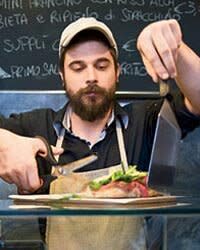
In this Article
Rome Restaurants: Where to Go Next 2013
—Elizabeth Minchilli
Coquis
This new cooking school (with classes in both Italian and English) has signed on amazingly talented chefs, including the two-Michelin-starred Claudio Sadler of Sadler in Milan and Giulio Terrinoni of Acquolina in Rome. Master pizzaiolo Pino Arletto teaches courses using the school’s wood-burning oven. Via Flaminia 575; 011-39-06-332-20082.
Coromandel
Notable in macho Rome, this restaurant is run by a woman, Katia Minniti, who has decorated the space with feminine, pale pink walls. There’s a fixed dinner menu with seasonal dishes like snapper atop lemon leaves, and a big breakfast with pancakes and bacon, not the usual shot of espresso and a cornetto.
RED
Feltrinelli, Italy’s biggest book publisher, has teamed up with Palermo’s famous restaurant Antica Focacceria S. Francesco to open a three-part space designed for book-browsing and leisurely dining. There’s a bookstore with WiFi-connected iPads, an adjacent food store that sells cheeses, salumi and pasta, and a café in back, which has garden seating and serves huge salads.
No.Au
Beer world superstars Teo Musso and Leonardo DiVincenzo and Roman pizza wizard Gabriele Bonci opened this tiny bistro, which has practically no kitchen. “It’s kind of MacGyver cooking,” says Bonci, who cooks squid with an iron. They have six Italian craft beers on tap.
Eataly
The Italian food empire launched its spectacular Rome behemoth in June. The biggest of 19 worldwide, this location includes 23 restaurants, bakeries, a gelateria and a rosticceria selling roast guinea hens. There’s also a cooking school with special classes, like a beer-making workshop. roma.eataly.it.
Rome Restaurants: Insider Picks
La Gensola
This outstanding restaurant has a long history: It first opened as a simple osteria at the end of the 19th century and has changed hands countless times, always in the same Trastevere location. Chef Claudio Dordei and his wife, Irene, took over in 2001 and added a few modern touches (including a life-size tree sculpture) in the otherwise traditional dining room. They serve some of the freshest seafood in Rome, including spaghetti and calamari tossed with sun-dried tomatoes, and a zingy sea bass ceviche. osterialagensola.it
L’Asino d’Oro
Chef Lucio Sforza looks to the rustic traditions of Tuscany, Lazio and Umbria at this casual, bright space in the hip Monti neighborhood. The food is heavy on pork, game and lentils, though Sforza adds sweet and tart elements as contrast, as in the guanciale (pig jowl) cooked in vinegar topped with crispy sage. The superb beer list includes Italian producers like Birra del Borgo. The lunch menu is an amazing value: three courses that change daily and a glass of wine for 12 euros. lasinodororoma.it
Osteria del Giuda Ballerino
Chef-owner Andrea Fusco’s Giuda Ballerino is two concepts in one, doubling the reasons to make the journey to Tuscolana—a half hour from central Rome. On one side of the building is a small, modern dining room serving refined dishes like phyllo dough–wrapped prawns with mortadella mousse; the other side houses the rustic Osteria, with a menu veering toward regional favorites like carciofi alla giudia (deep-fried artichokes) and tagliolini al nero di sepia (tagliolini with cuttlefish ink). giudaballerino.com
Rome Restaurants: Splurge

Photo courtesy of All’Oro.
Ristorante All’Oro
Young chef Riccardo di Giacinto has worked with Europe’s most talented chefs (Ferran Adrià, Marco Pierre White), and it shows—especially in his more experimental dishes, like a tiramisu made with salt cod, potato and lardo. He also turns the classic flavors of spaghetti carbonara into a main course of porchetta-wrapped sea bass on a bed of truffled carbonara sauce. The tiny, minimalist restaurant is one of only a dozen spots in Rome with a Michelin star. ristorantealloro.it
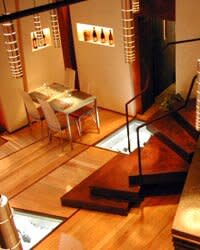
Photo © Glass Restaurant.
Glass Hostaria
With glass floors and pendant lights, this hyper-modern restaurant stands out in the cobblestoned Trastevere district. American chef Cristina Bowerman pushes the boundaries of Italian cuisine; hers incorporates French and Asian touches with unexpected textures (frozen crème fraîche, dehydrated Parma prosciutto) and esoteric ingredients (Sichuan peppercorns, kombu algae). glass-restaurant.it
Rome Restaurants: Classic
Flavio al Velavevodetto
This Testaccio restaurant is Slow Food founder Carlo Petrini’s favorite place to eat in Rome. Chef-owner Flavio De Maio expertly cooks all the Roman classics (all’Amatriciana, carbonara, tripe) as well as daily-changing specials, for very reasonable prices. Located at what was originally an ancient landfill—specifically, where the Romans would dump their cracked amphora—the dining room is decorated with ancient terra-cotta fragments. flavioalvelavevodetto.it
La Gatta Mangiona
Rome’s pizza cognoscenti count this long-running Monteverde joint among the city’s best for sit-down pies. The wood-fired creations combine both the tender, puffy-rimmed Neapolitan pies and their crisp-crusted Roman counterparts. Toppings include the classics (marinara, margherita) along with more original combinations like zucchini, onions and fior di latte. lagattamangiona.com
Perilli
This old-fashioned, modestly priced spot in the Testaccio neighborhood makes no concessions to tourists, starting with the eternally grumpy waiters. The decor, including the wood-paneled walls and murals of ancient Roman scenes, hasn’t changed for about 50 years—and neither have the extraordinary pastas: an extra eggy carbonara, amatriciana and the not-for-beginners pajata (made with calf intestines).
Rome Restaurants: Best Value
Settembrini
Four years ago, chef Luigi Nastri opened Settembrini to almost instant acclaim in Rome’s Prati neighborhood. A counter loaded with cheeses, hams and salumi takes up most of the softly lit dining room; the menu includes simple, expertly cooked fish and pastas. In 2011, Nastri opened two new places. Settembrini Caf&egreave; has an exceptional wine list, a cool cocktail scene and serves what many consider the city’s best gelato. Nearby is Set’, part bookstore, part market, selling take-out, craft beers from Birrificio del Ducato and La Molina cookies. viasettembrini.it

Photo © Andrea Wyner.
Pizzarium
Celebrity pizzaiolo Gabriele Bonci rescues the reputation of pizza al taglio (by the slice) at this closet-size spot, where he uses esoteric flours (like enkir, a type of spelt) and a 100-year-old sourdough starter to create fluffy, oblong pizzas that are cut and then priced by weight. He is said to use 1,500 ingredients per year, often in experimental toppings like “LSD”: licorice, sausage and dates.

Photo © Andrea Wyner.
Sforno
Considered one of Rome’s best sit-down pizzerias, this no-frills spot (green-and-white-checkered tablecloths, tile flooring) in the working-class Tuscolan neighborhood specializes in pies that skew Neapolitan-style, with light, puffy crusts. In an ingenious twist on the simple Roman pasta dish cacio e pepe, Sforno makes a terrific pie loaded with grated Pecorino and served with a pepper mill alongside. sforno.it
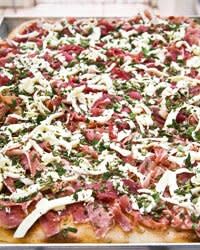
Photo courtesy of 0010 Pizza.
00100
This excellent pizza-by-the-slice operation from the owners of Sforno has one advantage over the hard-to-get-to original: It’s conveniently located in the heart of trendy Testaccio. (The numbered name refers both to the type of fine-milled flour used and the neighborhood’s zip code.) Beyond signature pizzas like the Greenwich (Stilton and mozzarella drizzled with a port reduction), there are trapizzini—triangular pockets filled with Roman ingredients like tripe in tomato sauce. 00100pizza.com
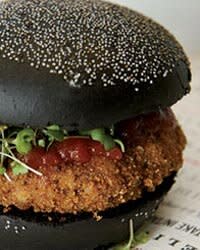
Photo © Andrea Wyner.
Tricolore
A bakery and sandwich shop by day and a cooking school by night, this place in the bohemian Monti neighborhood sells superseasonal, highly creative sandwiches, like a skate-and-broccoli-sprout burger on a squid ink bun, octopus on potato bread and anchovies and butter on rye. tricoloremonti.it
Gelato in Rome
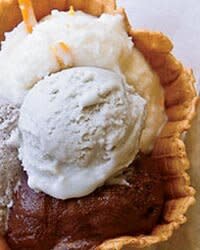
Photo © Andrea Wyner.
Il Gelato di Claudio Torcè
There are 20 varieties of chocolate alone at Claudio Torcè’s first gelato store, in central Rome, not far from the Spanish Steps, and usually about 100 flavors overall. He sources top-quality ingredients for his gelatos, which also come in out-there special flavors such as include Szechuan peppercorn, habanero and black sesame. web.tiscali.it/ilgelatodiclaudiotor
Gelateria dei Gracchi
Alberto Manassei’s gelateria near the Vatican serves creamy, pure gelato made with fine ingredients like wild strawberries and fresh-roasted, prized pistachios from the tiny Sicilian town of Bronte by Mount Etna. He’s a neoclassicist, so you won’t find the more experimental flavors of some of Rome’s other gelato geniuses. gelateriadeigracchi.com
Gelateria del Teatro
At this excellent gelateria near Piazza Navona, Stefano Marcotulli and his wife, Silvia, make all the classics (stracciatella, coffee), but they’re best known for experimental combinations like dark chocolate with Nero d’Avola wine and ricotta with fig and almond. Lucky customers nab one of the few tables in the little courtyard.
Rome Bakeries, Breakfast and Coffee
Panella L’Arte del Pane
This Roman bakery in Esquilino serves some of the city’s best breads, from crispy, salt-flecked grissini to puccia pugliese studded with whole olives. There are also terrific breakfast pastries and pizza al taglio (by the piece). The newly expanded coffee bar has extra seats (indoor and out) for lingering over a cappuccino or Prosecco. panella-artedelpane.it
Cristalli di Zucchero
This superb pasticceria is known for its jewel-like products, including buttery, cream-filled cornetti (the Italian answer to croissants), along with fruit tarts and cakes, which come in individual and mini portions. The original outpost in Monteverde has sandwiches too, and seating; the newest branch, near the Campidoglio, is take-out only. cristallidizucchero.it
Pasticceria Regoli
At the historic Regoli, now almost a century old, there’s a long glass case of enticing classic pastries, like the rightly famous maritozzi alla panna (sweet buns generously filled with whipped cream), fruit tarts piled high with wild strawberries and dusted with sugar, and creamy bavarese. The old-school shop has made no concessions to tourists who stop after visiting the nearby Colosseum: There are no seats, and no beverages are served. pasticceriaregoli.com
Best Bars in Rome
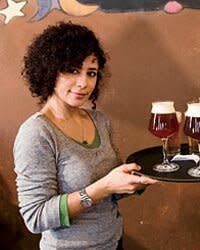
Photo © Andrea Wyner.
Open Baladin
Italy is producing some of the most interesting beer in the world, a movement that’s spearheaded by Turin’s rock-star brewer, Teo Musso, of Birra Baladin. He favors odd ingredients like ginger and myrrh, which he uses in the spicy Nora. It’s one of around 140 artisanal Italian brews that line an entire wall of Musso’s pub Open Baladin, which also serves beer-friendly dishes like burgers, buffalo wings and paprika-dusted chips. openbaladinroma.it
L’Angolo Divino
L’Angolo Divino opened as a wine shop just after WWII, and by the mid-’80s it had evolved into a wine bar, as many wine shops were doing at the time. Massimo Crippa, grandson of the original owner, currently runs the cozy enoteca, lined with wooden shelves of wine that’s mostly Italian and biodynamic. Along with house-made pastas, there’s a nice selection of smoked fish, cheeses and cured meats.
Il Goccetto
Enotecas don’t get more charming than this little spot near Campo de’ Fiori, which has about 10 tables and a rustic wooden ceiling. Like most wine bars around the city, there’s a spread of light bites: Italian cheeses, olives, cured meats and vegetable antipasti. But Il Gocetto’s strength lies in its stellar collection of Italian and French bottles, many of which are available by the glass. ilgoccetto.com
